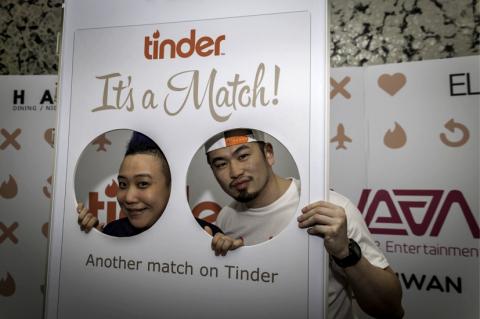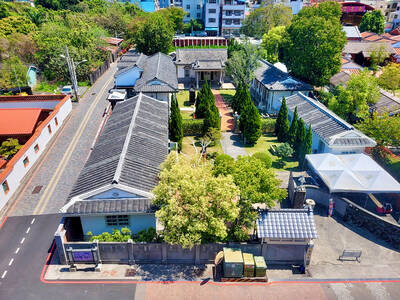Leanne McGoolsby first downloaded Tinder, the app that matches people based on mutual swipes, a few years ago in Taiwan. At first, she would go on dates with interesting people outside of her circles or those that were just visiting Taiwan for a short time. Eventually, she became involved in a relationship and did not need to use the app anymore.
After McGoolsby’s relationship fizzled out, she decided to try out the dating scene once again. This time, though, she got messages on Tinder that were somewhat off-putting and borderline creepy. One read, “I’ve got the little spoon position available for hire. What would you rate your cuddling abilities on a scale of 1 to 10?”
Another guy’s first pick-up line was, “I am a gentle man. I am here to love you.” McGoolsby then decided Tinder was not for her. “There are a lot of weirdos out there,” she said.

Photo courtesy of Jamie Mactography
Staff reporter Dana Ter was a first-time Tinder user and a skeptic. She had only heard horror stories about meeting people through dating apps, but still decided to give it a try. The first guy she matched with, she went to meet for a drink at 1am. After their date, Ter thought she would never see him again because it was Tinder and the guy was using the app to hook up while he was backpacking around the world. Surprisingly, though, Ter and her new boyfriend were soon inseparable and found themselves on the verge of something special.
LIFESTYLE APP
Tinder describes itself as a location-based social discovery app that helps mutually interested parties communicate with each other. When the app is mentioned casually in conversations though, a lot of people think Tinder is the way to find no-strings-attached one night stands nearby.

Photo courtesy of Tinder
According to Tinder spokesperson Evan Bonnstetter, this is far from the truth.
“Calling Tinder a hook-up app is a misconception. In fact, the vast majority of our users are looking to form meaningful, long-term relationships through Tinder. Tinder is for dating, friendships, marriage and everything in between,” Bonnstetter said.
An US Securities and Exchange Commission (SEC) filing which went public last month reported that Tinder had 9.6 million users by September. This means that there are a lot of people swiping left and right and looking for someone special. Now, Tinder is aiming to take on Taiwan by looking to connect people through their behaviors.

Photo courtesy of Jamie Mactography
Bonnstetter believes that Tinder has plenty of potential in Taiwan.
“Taiwan is in Tinder’s top 40 countries globally and in our top five markets in Asia,” he said.
To push into the Taiwan market, Tinder is sponsoring various nightlife activities such as ladies’ nights at clubs and the recently completed tour of the hip-hoppers, Far East Movement.
The plans are not just for when the sun goes down, though. Soon Tinder will be doing pop-up fitness classes in different areas of Taiwan as well as other events that match people through their lifestyle instead of just swiping right.
IS TRUE LOVE POSSIBLE ON TINDER?
McGoolsby says that finding soul mates on Tinder is possible. “Loads of my friends have met their significant others on there,” she said.
While Ter has experienced finding love on Tinder, she thinks that she is one of the lucky ones.
“If Tinder is solely based on looks and making quick judgments on people by having to swipe right or left based on their initial pictures, then it’ll be hard for it to move away from being primarily a hook-up app,” she said.
Ter believes that matching people through lifestyle choices is a good idea, but she doesn’t think that would make Tinder much different from Match.com or eHarmony, both dating Web sites that charge users. She thinks it is really up to the individual users to find the best way to use Tinder.
“I’ve had some guys message me saying they’re just looking for a fuck buddy, and other times, it ends up being a relationship. It’s all about chance really,” she said.

April 28 to May 4 During the Japanese colonial era, a city’s “first” high school typically served Japanese students, while Taiwanese attended the “second” high school. Only in Taichung was this reversed. That’s because when Taichung First High School opened its doors on May 1, 1915 to serve Taiwanese students who were previously barred from secondary education, it was the only high school in town. Former principal Hideo Azukisawa threatened to quit when the government in 1922 attempted to transfer the “first” designation to a new local high school for Japanese students, leading to this unusual situation. Prior to the Taichung First

Chinese Nationalist Party (KMT) Chairman Eric Chu (朱立倫) hatched a bold plan to charge forward and seize the initiative when he held a protest in front of the Taipei City Prosecutors’ Office. Though risky, because illegal, its success would help tackle at least six problems facing both himself and the KMT. What he did not see coming was Taipei Mayor Chiang Wan-an (將萬安) tripping him up out of the gate. In spite of Chu being the most consequential and successful KMT chairman since the early 2010s — arguably saving the party from financial ruin and restoring its electoral viability —

The Ministry of Education last month proposed a nationwide ban on mobile devices in schools, aiming to curb concerns over student phone addiction. Under the revised regulation, which will take effect in August, teachers and schools will be required to collect mobile devices — including phones, laptops and wearables devices — for safekeeping during school hours, unless they are being used for educational purposes. For Chang Fong-ching (張鳳琴), the ban will have a positive impact. “It’s a good move,” says the professor in the department of

Toward the outside edge of Taichung City, in Wufeng District (霧峰去), sits a sprawling collection of single-story buildings with tiled roofs belonging to the Wufeng Lin (霧峰林家) family, who rose to prominence through success in military, commercial, and artistic endeavors in the 19th century. Most of these buildings have brick walls and tiled roofs in the traditional reddish-brown color, but in the middle is one incongruous property with bright white walls and a black tiled roof: Yipu Garden (頤圃). Purists may scoff at the Japanese-style exterior and its radical departure from the Fujianese architectural style of the surrounding buildings. However, the property